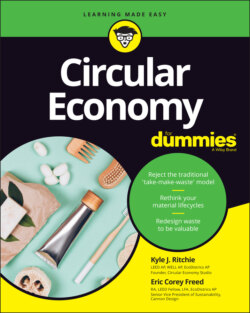Читать книгу Circular Economy For Dummies - Eric Corey Freed - Страница 39
We’re Taking the Wrong Stuff
ОглавлениеThe linear take-make-waste approach to work depends on the use of a lot of materials. Companies harvest and extract raw materials and use them to produce a product, which they then sell to consumers. Eventually, the consumer discards the product when it’s no longer of use to them. In 2020, more than 90 billion tons of raw materials were put into the linear system of production. The sheer scale of all this wasteful manufacturing activity is overwhelming.
Unfortunately, humans are harvesting materials that are limited in supply and difficult and expensive to extract — and the materials aren’t designed to be replenished. When those products end up in the landfill, they don’t magically restore the original raw materials. As a result, materials are getting increasingly more difficult (where we can even find a sufficient supply) to extract safely and affordably, harvest a useful supply, and ensure quality.
For example, as the supplies of easily accessible oil and natural gas have run out, it’s become harder and harder to find plentiful sources of those resources. Energy companies have had to drill deeper and go further offshore, and employ riskier techniques, such as fracking, to scrape up the last bits. As a result, the oil and gas they now extract is less pure, of lower quality, and more expensive to find.
Because nearly all linear systems either are powered by fossil fuels or use them to manufacture their products, products grow more expensive and difficult to produce. Costs rise, prices follow and rise, and consumer spending is affected. It’s difficult to keep running a linear economy when your key materials are volatile in price and availability.
The linear economy depends on the wrong assumptions: an endless supply of cheap, abundant energy and materials. Now that those things are no longer true, companies are starting to question their original assumptions and to transform from a linear economy to a circular one.
